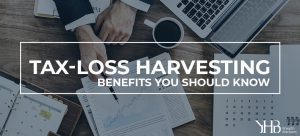
Every Investor Should Understand the Benefits of Tax-Loss Harvesting

Even in the best of times, not every investment will be a winner. Fortunately, losing investments do have a silver lining: You may be able to use them to lower your tax liability and better position your investment portfolio going forward. This strategy is called tax-loss harvesting, and it’s one of the many tax-smart strategies that investors should understand and consider using when appropriate.
Tax-loss harvesting is a strategy in which certain investment assets are sold at a loss in order to reduce your tax liability at the end of the year. You can use tax-loss harvesting to offset capital gains that result from selling an investment in securities, or another investment asset at a profit. You can also use tax-loss harvesting to offset up to $3,000 in non-investment (ordinary) income.
Tax-loss harvesting is a strategy that you can only apply to taxable investment accounts. Tax-deferred retirement accounts like IRAs and 401(k)’s grow deferred, so they aren’t subject to capital gains taxes, and therefore you can’t use any losses in these accounts to offset capital gains either in the accounts themselves, or another investment asset.
The Basic Strategy
Imagine you’re reviewing your portfolio and you see that your holdings in a particular sector or individual stock have risen sharply, while some of your holdings in another sector or individual stocks have dropped in value. As a result, perhaps you now have too much of your portfolio’s value concentrated in one sector. To realign your investments with your preferred allocation, you sell some of the appreciated stocks and use those funds to rebalance. In the process, you end up recognizing a significant taxable gain.
This is where tax-loss harvesting comes in. If you also sell the stocks that have declined in value, you could use those losses to offset the capital gains from selling the appreciated stocks, and reduce your tax liability.
In addition, if your losses are larger than the gains, you can use the remaining losses to offset up to $3,000 of your ordinary taxable income (for married couples filing separately, the limit is $1,500). Any leftover losses can be carried forward to future tax years and used to offset capital gains or ordinary income down the road.
Some Issues to Consider
As with any tax-related topic, there are rules and restrictions to be aware of before utilizing tax-loss harvesting, including:
- Tax-loss harvesting isn’t useful in retirement accounts such as a 401(k) or IRA, because the losses generated in a tax-deferred account cannot be deducted.
- There are restrictions on using specific types of losses to offset certain gains. A long-term loss would first be applied to a long-term gain. A short-term loss would be applied to a short-term gain. If there are excess losses in one category, these can then be applied to gains of either type.
- When conducting these types of transactions, you should also be aware of the wash-sale rule, which states that if you sell a security at a loss and buy the same or a “substantially identical” security within 30 days before or after the sale, the loss is typically disallowed for current income tax purposes.
The Bottom Line
It’s important to understand that the primary purpose of tax-loss harvesting is to defer income taxes. That’s the process of delaying the payment of taxes many years into the future. This allows an investment portfolio to grow and compound at a faster rate than it would if the money to pay taxes were withdrawn from the portfolio every year that gains occurred. The benefit will be fully maximized if you can defer the liability until after you stop working, when you will presumably be in a lower tax bracket.
Tax-loss harvesting is an investment principle well worth every investor putting in the time and effort to understand and properly utilize in their investment strategy.
The information in this article is provided with the understanding that the author is not herein engaged in rendering legal, accounting, tax, or other professional advice and services. As such, it should not be used as a substitute for consultation with professional accounting, tax, legal or other competent advisers. Before making any decision or taking any action, you should consult with your own accounting or financial advisor.


Randy has more than 15 years of experience managing financial assets for individuals, retirement plans and businesses. Randy joined YHB | Wealth Advisors in January of 2018 and serves as the Director of Wealth Management. Prior to entering the professional wealth management field, he enjoyed building entrepreneurial business ventures from start-up to eventual sale and providing accounting services for public and private firms.
